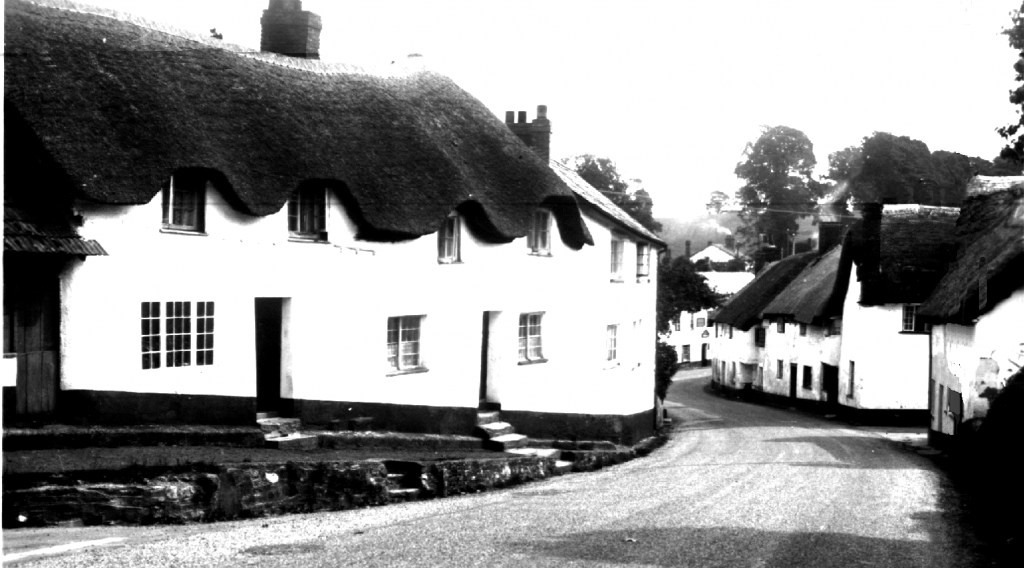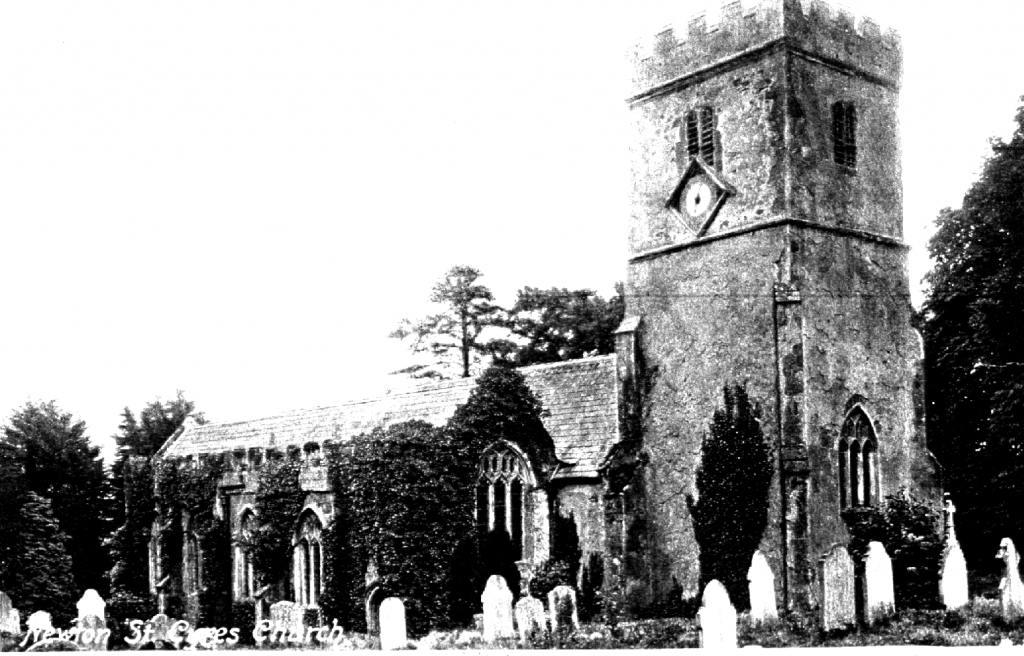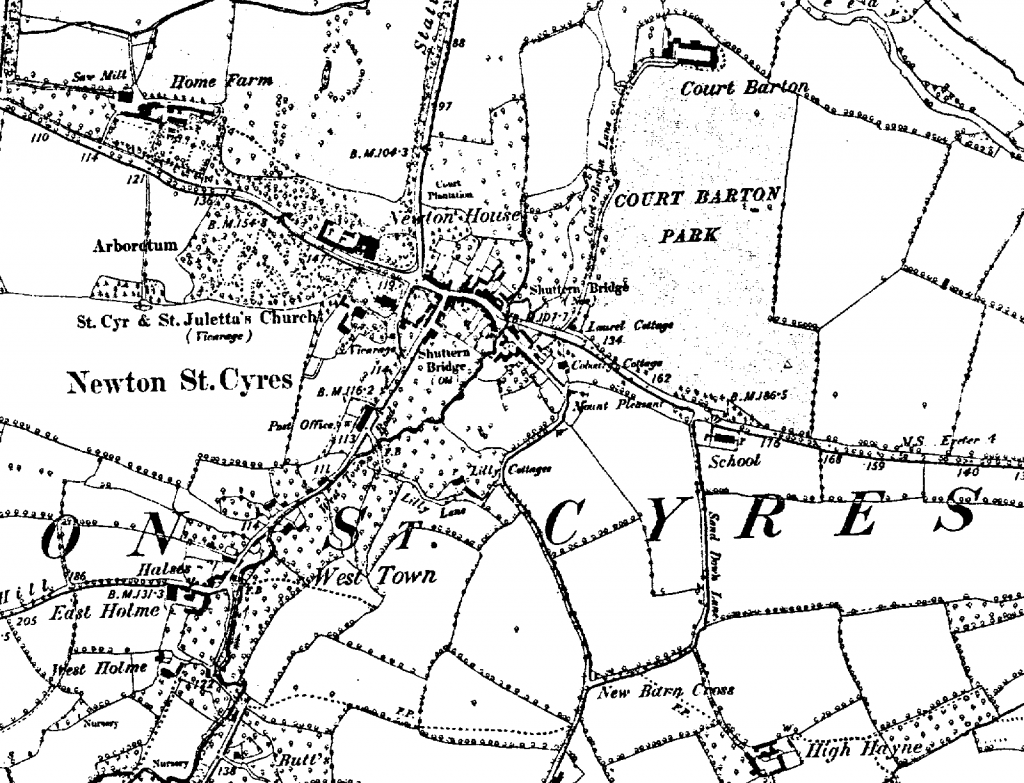The village of Newton St. Cyres

Newton St. Cyres is a small village on the road from Exeter to Crediton. It lies in a valley with wooded hills to the South and open ground to the North. The road from Exeter slopes down from the east side of the valley, runs through the village and climbs steeply up the west side. The parish church stands high above the village to the west close beside the road to Crediton. In the 18th century, the main village activity would be farming and in the early nineteenth century some small-scale mining took place a little to the south of the village. Ores for lead, some manganese and a little silver were extracted and processed elsewhere. Being on the main road from Exeter to Crediton, there would have been much activity servicing passing travellers There would have been plenty of work for blacksmiths, wheelwrights and coopers and innkeepers (there were four Inns in the village). At the height of these activities the population was about 1300. But in the mid-18th century it was less than half that number. In later years the population reduced again to about six or seven hundred.

The dedication of the church is unusual. It is to St. Cyr and St. Julitta. According to legend, Julitta and her young son Cyr were murdered by the Romans in Iconium, a town in what is now Turkey, for defying Emperor Diocletian’s edict banning Christianity.
Newton St. Cyres is ancient. It is listed in the Domesday Book as “Niewetone”. It was then held by a person called Dunn. He was one of the few Anglo-Saxons to retain his holding after the Norman conquest in 1066. But not for long. It eventually passed into the hands of Plympton Priory. At the Dissolution of the Monasteries the village was split between the Northcott family, rich woollen merchants, and the Quickes. The church has many monuments to these two families.
James and Elizabeth
On 25th May 1740 James Cuddeford married Elizabeth Helmore at the parish church of Newton St. Cyres. They lived in the village for the rest of their lives and their descendants continued there for at least 100 years. It is possible that James was a carpenter as there is a record in the church accounts showing the payment to him of one shilling and sixpence for 1000 laths (strips of wood used for tiling) for repairs to the church roof.
James had been living in the village some time before his marriage to Elizabeth. His signature appears as a witness on a document dated 28th March 1739. It seems quite likely that James was born in 1717 in the village of Ide some six miles away. James and Elizabeth had eight children.
Their first child, John, was baptised in the church on the 6th of January 1740. This date might suggest to us that John was born before his parents were married! However – we must remember that in 1740 the Julian calendar was still in use and the new year started on the 25th of March. Thus January comes after May. It was not until 1753 that the modern Gregorian calendar came into use in England.
The second son, Thomas, was born on the 20th December 1744 and was baptised on the seventh of January 1744. Their next child, Elizabeth, was born on the 29th December 1746 and baptised on the 9th of February 1746. She was followed by another son, James, born on the 16th of October 1749 and baptised ten days later. Robert, the fourth son, was born on the 1st December 1752 and baptised on the 6th.
The family now consisted of five children and all seemed well. Sadly however, the third son James died in April 1754 and was buried on the 24th. The second daughter, Ann, was born on 25th January 1756 followed by another daughter, Jane, born on 1st August 1759. In about 1760, tragedy struck again. The oldest son, John, died and was buried on the 11th May 1760 aged 20 and the youngest child, Jane, died at about that time. Consolation came in March 1761 with the birth of another daughter also christened Jane.
Now there were two sons, Thomas and Robert and their three sisters, Elizabeth, Ann and Jane. We have no record of what became of Elizabeth and Ann. Jane, however, married Nicolas Gover in Exeter on the 7th May 1788. Both sons, Thomas and Robert, married and raised families. Their father, James lived until 1790 and his wife Elizabeth until 1804. If James was indeed born in Ide in 1717, that would mean he lived to the age of 73, which at that time was a ripe old age (average life expectancy being about 40 years).
Thomas and Mary
Thomas (the eldest surviving son of James and Elizabeth) was apprenticed to Mr Ellis in 1759 at the age of 15 and he served his time to qualify as a butcher. He married Mary Brown in the village on 5th May 1767. It was in this year that the village was outraged to find that the Communion Plate had been stolen. The thief, a certain William Hockaday, had beaten it altogether for easy transport. He was eventually caught and hanged at Exeter. The silver was recovered and made into a new set of plate comprising a flagon, chalice with cover, alms dish and basin all inscribed ” The Communion Plate of Newton St. Cyres, Devon, 1767″
John, the first child of Thomas and Mary was born in the village on 1st April 1768 and baptised there on 25th. Two years later we find this family in the neighbouring village of Whitestone where the second son, James was born. This little family then moved to Plymouth and founded the ” Cuddefords of Plymouth”.
Robert and Hannah
Robert (the youngest son of James and Elizabeth) became a cooper. On the 26 January 1779 he married Hannah Saffin in Cheriton Bishop, a village about ten miles away to the West. They lived the rest of their lives together in Newton St. Cyres and raised a family of seven children, three boys and four girls.
First there was Grace born on 11 December 1779 but who died two months later. The first son, John was baptised 18th April 1781. We have no more information about him. Next came Maria born 15th August 1783 and who married James Holmes in Newton St. Cyres on 6 February 1805. Two years later came James born 30th September 1785 and baptised 18th of October. James, like his father, was a cooper and carried on his work in the same village for many years. He married Mary Dart on 20th October 1814 and they had a large family (see below). There followed two daughters, Jane and Ann in 1788 and 1791. We have no more information about these two. Finally, Robert was born 8th August 1793 and baptised in the September. This Robert (son of Robert the cooper) was a stone mason. He left Newton St. Cyres and went to Ilfracombe, a large town on the north coast of Devonshire where he met and married a widow Ann Rumney. They raised a family of four children becoming the ancestors of the ” Cuddefords of Ilfracombe”.
Robert senior died in 1832, aged 79, and was buried on 10th May. He appears to have been a successful cooper. In his Will, he nominated his sons James and Robert as executors. To his wife Hannah, he left the rent or income from an estate called Furzdown, then let to one John Sloeman, during her lifetime, together with furniture and other goods” as necessary for a single woman” all to be returned to the executors after her death. To his son Robert he left the family Bible. To his grandson Robert he left his sermon book; to his daughter Maria Holmes the interest on £75 and to the three other children his other books. Finally, to his grandson Robert his working tools. (He had two grandsons called Robert, we do not know which one got the tools).
The Family of James, son of Robert.
As we have seen above, James followed his father’s occupation of cooper. His marriage to Mary Dart took place in the parish church and resulted in a family of eight children. The first child was the daughter Mary Ann, she was baptised on the 23rd July 1850. Two years later she had a brother, James, baptised 5th January 1817. James, died in July 1821. The next child was Robert baptised on the 2nd January 1820 followed by Jane who was baptised 10th March 1822 but died the following month. Another daughter was baptised 8th February 1824. Her name was Caroline and she survived to marry George Taylor in 1853. The third daughter, Maria was baptised 16 April 1826 and she married Thomas Stabback in 1846. The last two children were boys, Thomas baptised 21st June 1829 and John baptised 3rd November 1833. Their father, James, died in 1854 and their mother in 1862. The family gravestone is inscribed as below:
Sacred to the Memory of
James Cuddeford
Cooper
the who died 17th Febry 1854
Aged 69 Years
Also James Son of the Above
who died 17th July 1821
Aged 4 years & 7 months
Also Jane, Daughter of the Above
Who died 7th April 1822
Aged 3 months
Also Mary Wife of the Above
James Cuddeford
Who Died 28th June 1862
Aged 65
All the surviving sons are of great interest. All three became coopers like their father and grandfather and all three left Newton St. Cyres to find work in other parts of the country. Thomas went to Burton on Trent, a town famous for brewing beer. There he married Agnes it 1854 and raised at least eight children. Thomas eventually became Head Cooper of one of the breweries and he died in Stafford on the 22nd February 1885. His story will be told in more detail in the ” Cuddefords of Stafford”.
The other brothers, Robert and John went to London and founded the Wine Merchant firm of ” Cuddeford Brothers ” in Miles Lane. Their story will be told in the ” Wine Merchant Cuddefords”.
With the departure of the three brothers and the death of their mother in 1862, the Cuddeford name was no longer found until much later when a distantly related family, using the name spelling Cuddiford, lived in the village.

Notes. The picture of the village above shows the main road looking towards Exeter. It shows the village as it was at the beginning of the 20th Century. In recent times, the road has been widened and many of the cottages have been demolished. The cottages seen in the picture are of “cob”. This is a method of building which uses a compressed mixture of local clay and straw to make the solid walls. Provided a stone foundation is used and the thatched roof is kept in good repair, such houses will last for centuries. “You must keep the feet and head dry”
The picture of the church also dates from the early 20th Century. Not much has changed since then. On the tower can be seen the clock. Installed in 1711 it ran for 194 years and then stopped. It was not until about 1975 that a parishioner restored it and added electric rewinding. In the picture, the dial can be seen as it points towards Newton House where the Lord of the Manor lived. It could not be seen from the village! With the restoration, the dial has been placed on the east side of the tower where it can now be seen from the village.